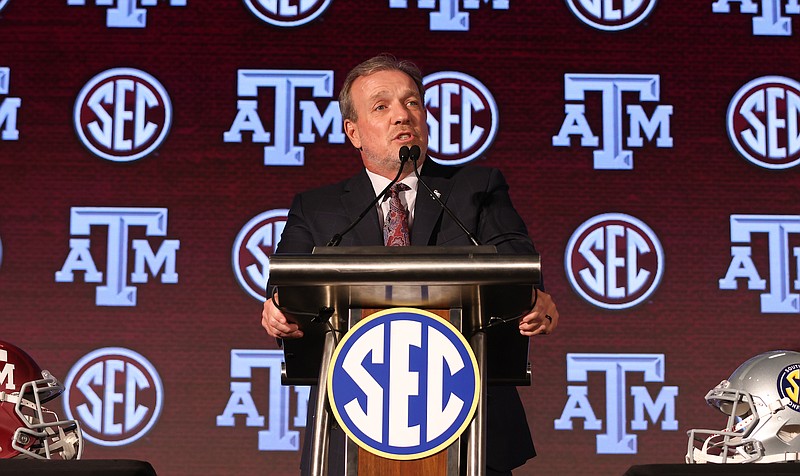Change is almost always hard. Yours truly is still coming to grips with the fact that the Earth is apparently round instead of flat. It's so much more comfortable for some of us when everything stays the same.
So do I really want to see Oklahoma and Texas become the newest members of the Southeastern Conference, ballooning the league where everything "just means more" to a whopping 16 schools?
Nooooooo way! I still long for the days when it was 10 schools instead of swelling to 12 with the addition of Arkansas and South Carolina in the early 1990s, then its current 14 thanks to the welcoming of Missouri and Texas A&M prior to the 2012 season.
But let's be honest here. College athletics as we've long known it, for better or worse, is over. Name, Image and Likeness has taken care of that. Once athletes begin playing for the name on the back of the jersey instead of the one on the front of the jersey or the side of the helmet, giving it "that old college try" will never mean the same.
In fact, if Alabama coach Nick Saban is correct (and when isn't Lord Saban correct?) that his new quarterback Bryce Young - the same Bryce Young who is yet to start a single, solitary game for the Crimson Tide - has already bagged close to $1 million in NIL contracts, that old chant of "Overrated" on those rare seasons Houndstooth U. loses a game is sure to be replaced by "Overpaid."
These young adults are now hired guns, whether the school is officially paying them or not. No more $500 handshakes under the table. They'll sign six- or seven-figure contracts over the table, pay noticeable taxes on them and try to pretend their schooling does still matter as long as it doesn't get in the way of their NIL obligations.
Just imagine the following conversation between Big State U.'s offensive coordinator and the school's star quarterback three days prior to the biggest game of the season:
Coach: "Hey, Johnny, could you drop by the office after practice to watch a little extra film on the Tigers' third-down blitz package?"
QB: "Uh, Coach, I'd love to but I'm already about to pass 20 hours of work for the week, it's only Wednesday and I've got two TikTok spots to shoot before midnight tonight. I'll try to fit you in tomorrow for at least 20 minutes."
Maybe it won't be like that. Maybe this generation of athletic freaks will surprise us by putting team - that's their school team, not their endorsement and management teams - above self.
But whether they do or don't, the SEC adding traditional football powerhouses Oklahoma and Texas won't change that. It will only make the strongest football conference in the land even stronger. It will lock up the Lone Star State for television revenue. Not to mention more national championships.
Merely consider that since 2000, 14 of the 21 college football national champs are either from the SEC, the University of Oklahoma or the University of Texas. Beyond that, 22 of the 42 participants in those title games were either from the SEC, OU or Texas. The rich will get richer. Period.
And the SEC is already filthy rich. Its revenue distribution for the 2019-20 school year was $657.7 million, that money generated by everything from TV rights to bowl revenue to the SEC title game, College Football Playoff, NCAA tourney and league basketball tourney. By comparison, the Big 12 reportedly distributed $377 million for the same school year. Even accounting for the fact that the SEC has 14 schools to 10 for the Big XII, that's a difference for the 2019-20 year of more than $9 million more per school for the SEC.
Of course, adding OU and Texas also figures to make it that much tougher on the bottom half of the league to be competitive in football.
Or as Kentucky coach Mark Stoops lamented last week about the possibility of expanding to nine or 10 league games on an annual basis after playing 10 a year ago due to COVID-19: "The league, there were quite a few people that struggled Take a good, hard look at what it did to half our league."
For the record, half the league had losing records. Of those seven, only UK went bowling. Six schools staying home for bowl season was the most since 2005. So if you're Vandy, Kentucky, the Mississippi schools, Missouri, maybe even South Carolina, expansion will likely grow your bank account far more than your trophy collection.
There's also the negative prospect of NIL to consider for all 16 schools, even Alabama.
No less than Saban noted this past week: "The question is because it's not going to be equal, and everything that we've done in college athletics in the past has always been equal. Some positions, some players will have more opportunities than others. And how that's going to impact your team, our team, the players on the team? (Can we make sure) people are not looking over their shoulder at what somebody else does or doesn't do?"
It's all a lot to absorb. Maybe too much. And it could indeed ruin college athletics as we've known it and loved it. But it's not just coming. It's here. And being unwilling to accept that could leave your program or conference as flat as some misguided folks once thought the Earth was.
Contact Mark Wiedmer at mwiedmer@timesfreepress.com
